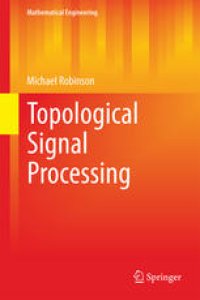
Ebook: Topological Signal Processing
Author: Michael Robinson (auth.)
- Tags: Signal Image and Speech Processing, Topology, Communications Engineering Networks, Computational Science and Engineering, Information and Communication Circuits
- Series: Mathematical Engineering
- Year: 2014
- Publisher: Springer-Verlag Berlin Heidelberg
- Edition: 1
- Language: English
- pdf
Signal processing is the discipline of extracting information from collections of measurements. To be effective, the measurements must be organized and then filtered, detected, or transformed to expose the desired information. Distortions caused by uncertainty, noise, and clutter degrade the performance of practical signal processing systems.
In aggressively uncertain situations, the full truth about an underlying signal cannot be known. This book develops the theory and practice of signal processing systems for these situations that extract useful, qualitative information using the mathematics of topology -- the study of spaces under continuous transformations. Since the collection of continuous transformations is large and varied, tools which are topologically-motivated are automatically insensitive to substantial distortion. The target audience comprises practitioners as well as researchers, but the book may also be beneficial for graduate students.
Signal processing is the discipline of extracting information from collections of measurements. To be effective, the measurements must be organized and then filtered, detected, or transformed to expose the desired information. Distortions caused by uncertainty, noise, and clutter degrade the performance of practical signal processing systems.
In aggressively uncertain situations, the full truth about an underlying signal cannot be known. This book develops the theory and practice of signal processing systems for these situations that extract useful, qualitative information using the mathematics of topology -- the study of spaces under continuous transformations. Since the collection of continuous transformations is large and varied, tools which are topologically-motivated are automatically insensitive to substantial distortion. The target audience comprises practitioners as well as researchers, but the book may also be beneficial for graduate students.